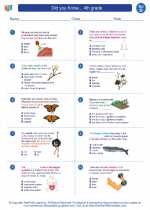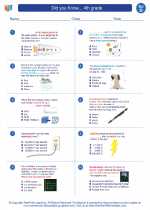Did you Know... 4th grade -> friction
Types of Friction
- Static Friction: This type of friction occurs when an object is at rest and an external force is applied to move it. The force of static friction prevents the object from moving until the applied force overcomes it.
- Sliding Friction: Sliding friction occurs when two surfaces slide past each other. It opposes the motion of the object and can cause the object to slow down.
- Rolling Friction: Rolling friction occurs when an object rolls across a surface. It is generally less than sliding friction, making it easier for objects to roll than to slide.
Factors Affecting Friction
Several factors can affect the amount of friction between two surfaces:
- Surface Texture: Rough surfaces create more friction than smooth surfaces.
- Applied Force: The greater the force applied to an object, the greater the friction.
- Surface Area: The larger the surface area in contact, the greater the friction.
- Types of Materials: Different materials have different levels of friction when in contact with each other.
Reducing Friction
Friction can be reduced through various methods, including:
- Lubrication: Adding a lubricant, such as oil or grease, between surfaces to reduce friction.
- Smoothing Surfaces: Polishing or smoothing the surfaces in contact to reduce the roughness and minimize friction.
- Using Wheels or Ball Bearings: These objects can reduce friction by allowing for rolling rather than sliding.
Applications of Friction
Friction is present in many everyday situations, including:
- Walking: Friction between the soles of our shoes and the ground allows us to walk without slipping.
- Braking: Friction between brake pads and a vehicle's wheels allows for efficient braking.
- Writing: Friction between the pen/pencil and paper allows us to write or draw.
Study Guide: Friction
When studying the topic of friction, consider the following key points:
- Define friction and its types: static, sliding, and rolling.
- Explain the factors that affect friction, such as surface texture, applied force, surface area, and types of materials.
- Discuss methods for reducing friction, including lubrication, smoothing surfaces, and using wheels or ball bearings.
- Explore real-life applications of friction in various scenarios.
[Friction] Related Worksheets and Study Guides:
.◂Science Worksheets and Study Guides Fourth Grade. Did you Know... 4th grade
Study Guide Did you Know... 4th grade
Did you Know... 4th grade  Worksheet/Answer key
Worksheet/Answer key Did you Know... 4th grade
Did you Know... 4th grade  Worksheet/Answer key
Worksheet/Answer key Did you Know... 4th grade
Did you Know... 4th grade  Worksheet/Answer key
Worksheet/Answer key Did you Know... 4th grade
Did you Know... 4th grade 

 Worksheet/Answer key
Worksheet/Answer key
 Worksheet/Answer key
Worksheet/Answer key
 Worksheet/Answer key
Worksheet/Answer key

The resources above cover the following skills:
Core Ideas for Knowing Science
Life Science
Organisms are organized on a cellular basis and have a finite life span.